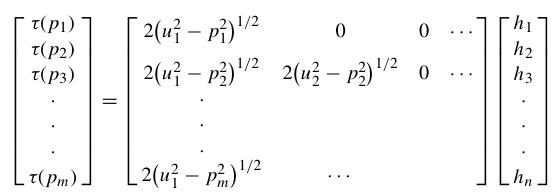Refer to Chapter 5, Introduction to Seismology, Shearer 2009.
Problem:
From the P-wave travel time data below (note that the reduction velocity of 8km/s), inverse for the 1D velocity model using T(X) curve fitting (fit the T(X) curve with lines, then invert for the ray parameter p and delay time τ(p), then solve for the velocity and depth).

Solution:
We construct the T(X) plot from the data: y = T – X/8 => T = y + X/8 and then divide the T(X) curve into fitting lines (Fig. 2).

The ray parameter and delay is calculated for each line by using:
p = dT/dX
τ = T – pX
These parameters p and τ are slope and intercept of a line, respectively.
The τ(p) can be written as:

as in the matrix form of:

or, in short,
We can invert for the thickness of each layer using least square inversion:
If we assume ray slowness u(i) = p(i) for each line, we can solve the h and v for the 1D velocity model.
Here is the result of the inversion:

The sharp increase in Vp from ~6.6 km/s to 7.7 km/s at ~ 30km depth suggest for the Moho discontinuity.
The codes for the problem is written in python and can be downloaded: source code, τ inversion code, data points.
Nguyen Cong Nghia, IESAS